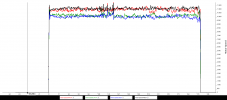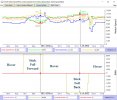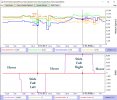well here's mine. not bent or deflected like you have pictured...
@TruGreen Have you had a chance yet to do a hover test? I'm very curious to see your results. ?
My Mini had always been carefully stored in the Fly More case, and my props looked just like yours. They slid together effortlessly when folded to nest into the case. It didn't seem to make any difference which ones went over/under the opposites side because the blades sat pretty much level and parallel to each other when crossed. And, as far as I could tell, the Mini flew perfectly fine and normal like that.
Yes, I received the occasional Max Power warnings, but I ignored them because the Mini always kept flying anyway. It was only when DJI changed the warning in firmware v01.00.0500, specifically telling me that I should replace the propeller blades, that I considered taking the warnings more seriously.
If you purchased the Mini as a Fly More Combo, you will have received spare sets of props. I did. I've never crashed my Mini, never run it into branches or anything, always hand-catch when landing to avoid sand and stones, etc. I believed my original props were still perfect as-is. But I had spare props to play with, so why not change them. If I ever did crash the thing and needed more replacement blades, I could always just pop the original blades back on, as I could see
nothing at all wrong with them.
But, as I explained in my previous posts above, once installed the new props were obviously different and the Motor Speed data plots conclusively demonstrated that they work better.
If you're thinking of doing your own hover tests (please do!), here's my two-minute test for comparison with all new prop blades installed, all except for the right-front motor which still has the original pair of blades on it. The motor speeds average out to around 9600 rpm.

For comparison, here's a hover test posted in another forum by someone else. Note, at hover, the
left-rear motor (blue line) is spinning
consistently much faster than the others. That's because the flattened left-rear prop blades are not producing sufficient lift. Consequently the right-front (red)
other counter-clockwise rotating motor is working much harder as well.
All of the motors are running faster to make up for the loss of lift from the left-rear.

Here's a quick one-minute test with mine. Note that it takes about 30 seconds for the Mini to stabilize itself into a steady hover. So be patient and let yours sit in a hands-free hover for at least 2 to 5 minutes. I loaded the CSV file into an Excel spreadsheet to calculate the average motor speeds, discarding any values under 800 rpm to eliminate the takeoff and landing portions of the graph. I should have cut off the entire first 30 seconds, which account for the LBack distorting the average. You can see that in the second half of the plot the motors are all running at near equal speed.

For one more comparison, here is the same hover test but this time with the DJI prop guards (cages) installed. In case you are nervous letting your Mini hover hands-free indoors without the prop guards fitted, here you can see the effect the extra weight of the cages has on motor speeds. Again it took about 30 seconds for the Mini to find a stable hover, after which the motor speeds equalized at around 1000rpm faster than without the guards installed.

As you can see, the hover test is an unbiased and accurate way to conclusively measure your propeller blades' effectiveness. Unless your blades are obviously cracked or broken, there's really no other way to tell if they're working okay. The propeller deformation can be quite subtle and difficult to detect visually. The hover test is quick and simple.





















